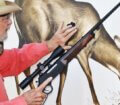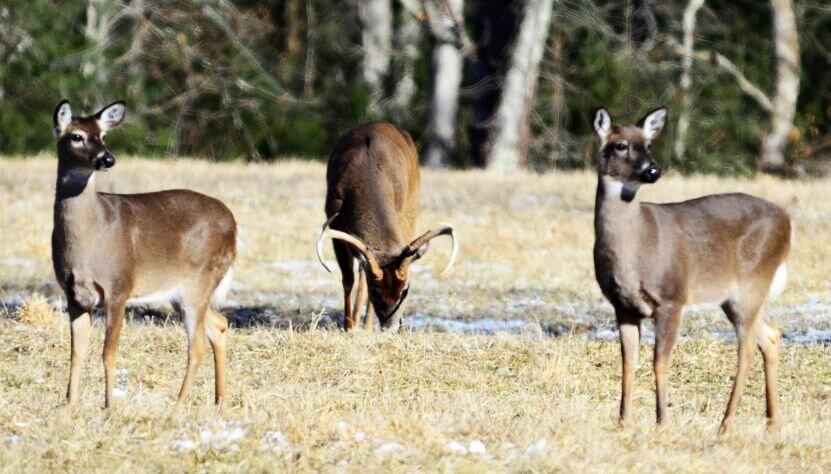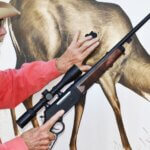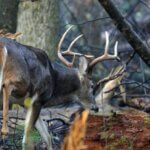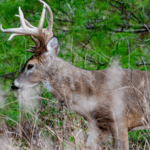Editor’s Note: Patterning is a term used frequently in the out-of-doors. Fishermen talk about patterning bass, duck hunters speak of patterning waterfowl, and deer hunters discuss patterning deer. What few of us fail to realize is that deer pattern people to survive. The older the buck, the quicker he learns to pattern hunters. The greater the hunting pressure, the easier the people and the deer are to pattern. Young bucks often die quickly. Older bucks that rely on their instincts from years past know when, where and how to retreat for cover when a human enters the woods. If you understand the mature buck deer, then you can think like him. Each buck in every situation is different, but let’s look at some examples of how to hunt these monarchs of the woods.

Realize That Older Bucks Use Younger Deer and Does as Decoys
Old bucks have another survival tactic they use. They permit young bucks and does to die first. A trophy buck will sacrifice other deer in the herd before he will place himself in harm’s way, because he’s learned the hunter usually is attempting to bag any deer. Often a mature buck will allow does and young bucks to walk ahead of him, even when he’s traveling in thick cover.
To take that trophy buck, you must have nerves of steel and let does and smaller bucks pass under your stand, although they are within easy range. These are the decoy deer that move ahead of the woods’ monarchs. Remember, if a trophy buck isn’t in the area you’re hunting, you may be able to come back later and bag one of the smaller bucks or does.

Don’t be fooled by the live decoy deer. Instead use these deer to decoy the buck. Let them pass in front of you to prove to the older buck no danger is around him. Then when he walks out, you can bag him. This tactic requires patience and willpower. To outsmart this intelligent animal, we must reason like him and use the information the trophy buck has learned to cause his downfall.

Hunt Trophy Bucks During the Rut When They’re Constantly Moving
During the rut, the dominant buck has the responsibility of breeding all the does that come into estrus within his home range. For this reason, he constantly must stay on the move and sometimes expose himself to the hunter. However, the more-mature bucks that have survived several rutting seasons often will make their scrapes in thick cover to elude hunters. Check sites of heavy cover for scrapes to hunt in the rut. The older and bigger the buck you want to take, the more he knows about you. Many mature bucks that are trophies and survivors have PhDs in hunter eluding. To bag a prize like this, you must reason like a buck.

How to Hunt and Take Big Buck Deer on Small Properties
In this book, you’ll hear from 14 hunters who either have gained permission or leased properties as small as six acres to as much as 250 acres, and how they consistently take older-age-class bucks off these little lands.
VERSIONS: AUDIBLE, KINDLE & PRINT

Jim Crumley’s Secrets of Bowhunting Deer
Using a black magic marker and a gray work jumpsuit, Jim Crumley of Buchanan, Virginia, drastically changed the nature and purpose of hunting camouflage when he created the first sportsman’s camouflage – Trebark. Crumley’s love of bowhunting and his desire to be more invisible changed hunting clothing forever.
In this hunting guide, he shares the wisdom that he’s learned throughout his lifetime about how to be a hunter, how to find a deer lease, how to scout for deer, and more.
Special features include how to:
- Have a magic 60 acres to hunt
- Decide the best equipment to use
- Find deer year-round
- Locate land to hunt
- Know the best place to put your tree stand
- Get bucks within bow range
VERSIONS: AUDIBLE, KINDLE & PRINT

How to Hunt Deer Like a Pro
How do you know if the land you hunt has a trophy deer on it? Wildlife manager Bob Zaiglin, of Uvalde, Texas and Jim Crumley, the father of modern-day hunting camouflage, tells you how to find out. GPS can make finding and taking that trophy buck easier. This hunting guide will teach you how to hunt big bucks where no one else can find them, how to call deer, and how to become versatile as a deer hunter, so that if one deer tactic doesn’t work, another one will.
In the chapter, “How to find Bucks at Scrape,” Dr. Keith Causey, retired professor of Wildlife Science at Auburn University, describes the best way to hunt a scrape.
Brad Harrison of Neosho, Missouri, is a nationally-known videographer, professional deer hunter and master at calling deer. Another master is Will Primos of Primos Game Calls. These two experts will tell the best deer calls and when to use them in this book.
And for over 20 years, Bo Pitman, lodge manager of White Oak Plantation, has been studying deer movement patterns. He explains what types of conditions are best for predicting deer movement.
VERSIONS: AUDIBLE, KINDLE & PRINT

Deer hunting and deer hunters are drastically changing each year. To learn new techniques for hunting deer and have more places to hunt, I’ve interviewed some of the best deer hunters in the nation and share their tactics in How to Hunt Deer Like a Pro: Volume II.
In Chapter 10, Jacob Lamar tells you his tactics for consistently taking older-age-class bucks on public lands in several states. Chapter 11, Bob Walker explains how to find places on public lands where you can hunt that 99 percent of the other hunters never have considered hunting. The Bonus Chapter with David Ramey tells you how, where, when and with what equipment to take big Kansas bucks on public lands by hunting in 100-degree weather when others won’t hunt.
Chapter 13, Mark Drury, his family and his guests take mature bucks every season by having more small places to hunt rather than one large property. Drury explains the strategy of having satellite farms to hunt that only may be 50-150 acres each or less. Chapter 15, Pat Reeve, who hunts far-northern states and Canada, says, “I don’t like hunting for mature bucks until the weather is 20 degrees or less.” Chapter 4, Dr. Larry Marchinton says that funnels are the most-reliable stand sites to hunt for big bucks and tells why.
VERSIONS: AUDIBLE & PRINT

